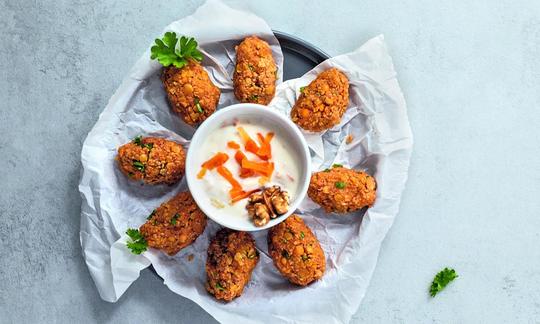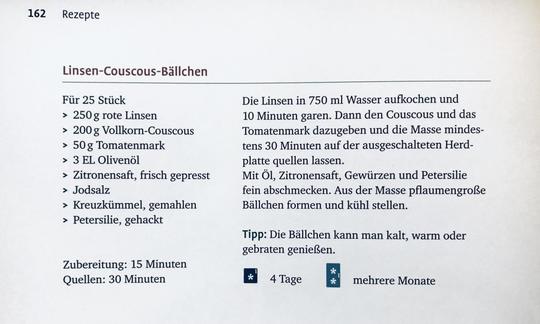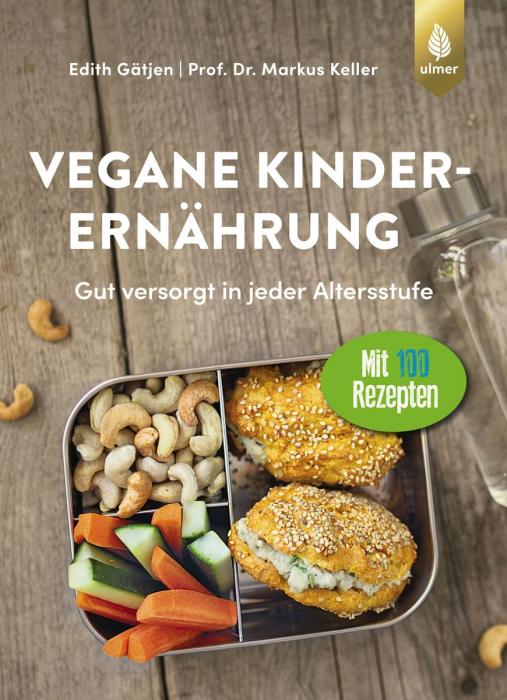Lentil Couscous Balls with Cumin
vegan
Ingredients (for servings, )
| 8 ½ oz | Lentils, red, raw (Erve, kitchen lentils) |
| 750 ml | Drinking water, raw (organic?) (26 oz) |
| 7 ⅓ oz | Couscous (raw? organic?) |
| 1 ¾ oz | Tomato paste, unsalted (organic?, raw?) |
| 1 tbsp | Lemon juice (raw?, organic?) (0.26 oz) |
| 4 tbsp | Parsley, fresh, raw (leaf parsley, parsley) (0.53 oz) |
| 1 tbsp | Olive oil (cold pressed, raw?, organic?) (0.47 oz) |
| 1 dash | Table salt (table salt, raw?, organic?) (0.01 oz) |
| 1 dash | Cumin, ground (raw, organic?) (0.00 oz) |
Equipment
- stove
- refrigerator
- citrus juicer (lemon squeezer)
- saucepan
Type of preparation
- cook
- chop or grind
- squeeze
- cool
- season to taste
- bring to a boil
- Quellen lassen (ausquellen)
Preparation
Preparation
Boil the lentils in 750 ml of water and cook for 10 minutes.
Add the couscous and tomato paste and let the mixture swell on the switched off stove for at least 30 minutes.Adjust the amount of water to use according to the instructions on the couscous package.
Squeeze the lemon and finely chop the parsley. Season the mixture from the previous preparation step with oil, lemon juice, spices and chopped parsley.
You decide for yourself how much lemon juice and spices to use. The original recipe does not give any exact details.
We reduced the amount of oil for 5 servings from 3 to 1 tablespoon (see also "Alternative preparation").
Finishing the lentil couscous balls
Form plum-sized balls from the mixture and place in a cool place.The balls can be served cold, warm or fried.
The specified amount for 5 portions yields approximately 25 lentil couscous balls.
Shelf life: The lentil couscous balls will last for 4 days in the refrigerator and several months in the freezer.
|
Nutritional Information per person
Convert per 100g
|
2000 kcal | |
|---|---|---|
| Energy | 363 kcal | 18.1% |
| Fat/Lipids | 4.1 g | 5.9% |
| Saturated Fats | 0.62 g | 3.1% |
| Carbohydrates (inc.dietary fiber) | 65 g | 24.0% |
| Sugars | 1.3 g | 1.4% |
| Fiber | 7.9 g | 31.7% |
| Protein/Albumin | 18 g | 35.2% |
| Cooking Salt (Na:52.2 mg) | 133 mg | 5.5% |
| Essential micronutrients with the highest proportions | per person | 2000 kcal | |
|---|---|---|---|
| Min | Copper, Cu | 0.81 mg | 81.0% |
| Prot | Tryptophan (Trp, W) | 0.18 g | 73.0% |
| Prot | Threonine (Thr, T, irreversibly transaminated) | 0.60 g | 64.0% |
| Min | Manganese, Mn | 1.2 mg | 60.0% |
| Prot | Isoleucine (Ile, I) | 0.75 g | 60.0% |
| Vit | Vitamin B9, B11 (Folate, as the active form of folic acid) | 116 µg | 58.0% |
| Prot | Phenylalanine (Phe, F) | 0.88 g | 57.0% |
| Prot | Leucine (Leu, L) | 1.3 g | 53.0% |
| Prot | Lysine (Lys, K, irreversibly transaminated) | 0.99 g | 53.0% |
| Prot | Valin (Val, V) | 0.85 g | 53.0% |
Detailed Nutritional Information per Person for this Recipe
The majority of the nutritional information comes from the USDA (US Department of Agriculture). This means that the information for natural products is often incomplete or only given within broader categories, whereas in most cases products made from these have more complete information displayed.
If we take flaxseed, for example, the important essential amino acid ALA (omega-3) is only included in an overarching category whereas for flaxseed oil ALA is listed specifically. In time, we will be able to change this, but it will require a lot of work. An “i” appears behind ingredients that have been adjusted and an explanation appears when you hover over this symbol.
For Erb Muesli, the original calculations resulted in 48 % of the daily requirement of ALA — but with the correction, we see that the muesli actually covers >100 % of the necessary recommendation for the omega-3 fatty acid ALA. Our goal is to eventually be able to compare the nutritional value of our recipes with those that are used in conventional western lifestyles.
| Essential fatty acids | per person | 2000 kcal |
|---|---|---|
| Alpha-Linolenic acid; ALA; 18:3 omega-3 | 0.15 g | 8.0% |
| Linoleic acid; LA; 18:2 omega-6 | 0.80 g | 8.0% |
| Essential amino acids | per person | 2000 kcal |
|---|---|---|
| Tryptophan (Trp, W) | 0.18 g | 73.0% |
| Threonine (Thr, T, irreversibly transaminated) | 0.60 g | 64.0% |
| Isoleucine (Ile, I) | 0.75 g | 60.0% |
| Phenylalanine (Phe, F) | 0.88 g | 57.0% |
| Leucine (Leu, L) | 1.3 g | 53.0% |
| Lysine (Lys, K, irreversibly transaminated) | 0.99 g | 53.0% |
| Valin (Val, V) | 0.85 g | 53.0% |
| Methionine (Met, M) | 0.19 g | 20.0% |
| Vitamins | per person | 2000 kcal |
|---|---|---|
| Vitamin B9, B11 (Folate, as the active form of folic acid) | 116 µg | 58.0% |
| Vitamin B1 (Thiamine) | 0.33 mg | 30.0% |
| Vitamin K | 17 µg | 22.0% |
| Vitamin B6 (pyridoxine) | 0.27 mg | 19.0% |
| Vitamin B3 (Niacin) | 2.5 mg | 16.0% |
| Vitamin B5 (Pantothenic acid) | 0.70 mg | 12.0% |
| Vitamin C (ascorbic acid) | 7.6 mg | 10.0% |
| Vitamin B2 (Riboflavin) | 0.10 mg | 7.0% |
| Vitamin E, as a-TEs | 0.84 mg | 7.0% |
| Vitamin A, as RAE | 22 µg | 3.0% |
| Vitamin B7 (Biotin, ex vitamin H) | 0.65 µg | 1.0% |
| Essential macroelements (macronutrients) | per person | 2000 kcal |
|---|---|---|
| Phosphorus, P | 225 mg | 32.0% |
| Potassium, K | 521 mg | 26.0% |
| Magnesium, Mg | 54 mg | 15.0% |
| Sodium, Na | 52 mg | 7.0% |
| Calcium, Ca | 46 mg | 6.0% |
| Essential trace elements (micronutrients) | per person | 2000 kcal |
|---|---|---|
| Copper, Cu | 0.81 mg | 81.0% |
| Manganese, Mn | 1.2 mg | 60.0% |
| Selenium, Se | 27 µg | 49.0% |
| Iron, Fe | 4.6 mg | 33.0% |
| Zinc, Zn | 2.2 mg | 22.0% |
| Fluorine, F | 107 µg | 3.0% |
| Iod, I (Jod, J) | 0.28 µg | < 0.1% |
Verlag Eugen Ulmer, Markus Keller und Edith Gätjen
Raw recipes 10, Cooked recipes 96 (3)
Additional photos (6)
"Vegan Children's Nutrition - Well Cared For at Every Age" provides sound information as well as healthy and simple recipes for families with children.
Since this book is written in German, a description is omitted here. If you are interested, please switch to German in the menu.
The lentil couscous balls with cumin can be served cold, warm or fried, as finger food with a dip or as a side dish.
Serving size: The indicated amount for 5 servings yields approximately 25 lentil couscous balls.
Nutrient profile: According to GDA guidelines, one portion of this recipe covers more than 50% of the average daily requirement of 7 out of 8 of the classic essential amino acids. You can find out more by clicking on the corresponding amino acids in the fold-out nutrient table below the recipe images.
Copper, which is involved in the endogenous antioxidant system and in the formation of connective tissue, pigments and hemoglobin, and manganese, which plays a role in the formation of cartilage tissue, are also covered by over 50%. The ratio of omega-6 to omega-3 fatty acids is 5:1, which is within the maximum recommended ratio. More on this under: Vegans often eat unhealthily. Avoidable nutritional errors .
However, the heating during cooking causes the food to lose some of its nutrients. Since the nutrient profile refers to the uncooked ingredients, the values are actually somewhat lower.
Red lentils: Due to their high-quality proteins, lentils are a very good source of plant-based protein for vegans. The different types of lentils, which are uniformly round and flat in shape, differ not only in size but also in color. Red lentils come from India and are particularly well-known from the national dish Dal. Because they are peeled, they cook quickly and break down into a kind of mush. Soaking beforehand is therefore not necessary. Because they are not peeled, they absorb the flavor of spices particularly well.
Couscous: Couscous is a dish from North African cuisine. It is made from moistened, ground semolina made from durum wheat, barley or millet. To cook the small balls, you just need to pour boiling water over them and let them steep. Couscous tastes aromatic and nutty.
Cumin: Due to the similar name, there is often confusion between cumin and caraway. They are not closely related and also differ greatly in taste. Cumin is often used in Indian, Turkish and Greek cuisine. The aroma is particularly intense if you grind the cumin fresh or crush it finely with a mortar.
Shelf life: The lentil couscous balls will last for 4 days in the refrigerator and several months in the freezer.
Serving: If you serve the lentil couscous balls as a starter, a dip is a good side dish. You can find a recipe for a carrot yoghurt dip on the same page in the same book.
You can also serve these lentil couscous balls as a main course with salad or vegetables or in a bowl.
If you like oriental-spicy dishes, you can also add harissa paste. You can find a list of ingredients for your own paste in the following recipe: Cauliflower steaks with harissa
Reduce oil: We reduced the amount of oil from 3 to 1 tablespoon in 5 portions and were thus able to reduce the ratio of omega-6 (LA) to omega-3 fatty acid (ALA) from 7:1 to 5:1.
Olive oil versus rapeseed oil: Economic forces and lobbying have made olive oil a cult oil, although the omega-6 to omega-3 fatty acid ratio is well above the recommended maximum ratio of 5:1. Compared to olive oil, rapeseed oil has several times higher proportions of essential fatty acids, especially omega-3 fatty acids.
By replacing 1 tablespoon of olive oil with 1 tablespoon of rapeseed oil, you can further improve the ratio of omega-6 (LA) to omega-3 fatty acids from 5:1 to 3:1.






